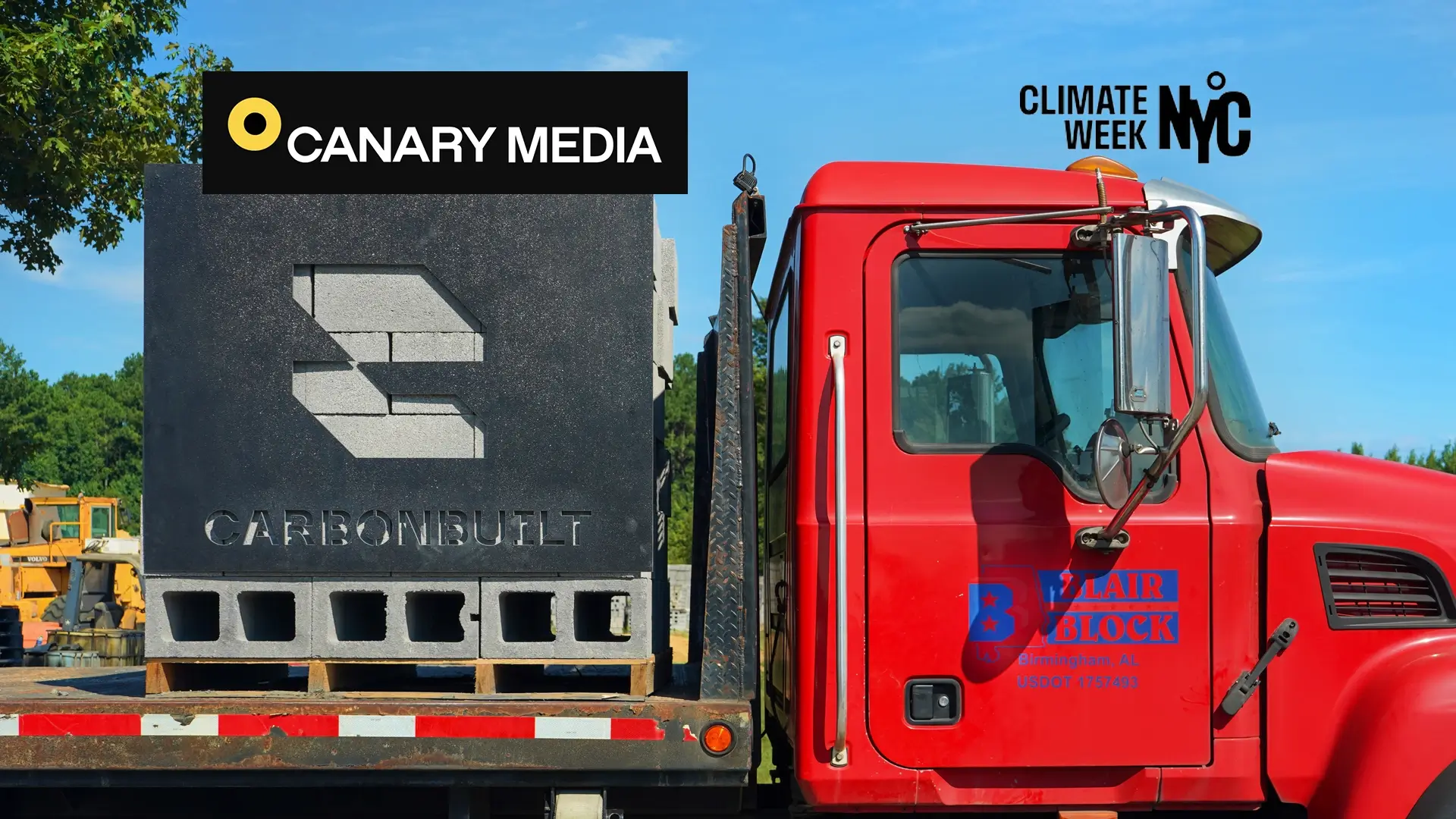Demand for low-carbon concrete is rising. CarbonBuilt says it has a potential solution: Concrete without any Portland cement.
Maria Gallucci at Climate Week NEW YORK CITY | Original Article: Canary Media
The startup CarbonBuilt has hit a key milestone in its quest to kick a notoriously carbon-intensive ingredient out of concrete.
On Thursday, the Los Angeles–based company said it had eliminated the use of “ordinary Portland cement” in its low-carbon concrete blocks, allowing CarbonBuilt to drastically reduce the amount of embodied carbon associated with its products. The announcement, made during Climate Week NYC, arrives as construction firms and developers are signaling greater demand for zero- and low-carbon concrete — very little of which is actually available today.
Nearly all of the world’s concrete contains Portland cement, a limestone and clay fusion that’s cheap, abundant — and extremely carbon-intensive to produce. As a result, cement and concrete production are responsible for roughly 8 percent of human-caused global CO2 emissions every year.
CarbonBuilt’s approach involves replacing traditional Portland cement with calcium-rich, low-carbon industrial waste materials. In May, the company began commercial production of its sustainable concrete at a partner facility in the city of Childersburg, Alabama.
Since then, CarbonBuilt has been working to gradually scale down the share of Portland cement in its mix and boost the percentage of alternative materials.
“We’ve done several test runs to figure out how low we can go with cement, and the team finally got it to zero,” JJ Steeley, head of marketing and strategic partnerships, told Canary Media this week over breakfast in Manhattan.
The achievement means “these blocks will now contain near-zero embodied carbon,” she added.
CarbonBuilt and its local partner Blair Block said they plan to produce the Portland-cement-free blocks at “commercial volume” in Alabama starting in early 2024.
Their goal is to steadily ramp up until they reach full capacity of 6,000 blocks per day.
At least a dozen other startups and manufacturers are working to develop their own concoctions to dramatically reduce or replace the use of carbon-intensive cement in concrete — the world’s most common building material, used in everything from buildings, bridges and roads to dams, power plants and wind-turbine foundations.
Most recently, the startup Terra CO2 Technology announced plans to build a commercial-scale facility in Texas to make its supplementary cementing material. The Colorado-based company has devised a way to turn some of the world’s most abundant and commonly used minerals into a drop-in replacement for the additives used in cement production, as Canary Media previously reported.
Another firm, Brimstone, has developed a process to convert basalt rock into a cement alternative. In July, the California-based company received third-party certification that says its product is structurally and chemically the same as ordinary Portland cement — which makes Brimstone the first among its peers to receive such validation, according to the company.
The secret sauce of low-carbon concrete without Portland cement
CarbonBuilt’s own technique involves combining its “secret sauce” of calcium-rich binding materials with captured carbon dioxide, Steeley said.
To start, CarbonBuilt mixes the materials with water and aggregates, which are then pressed into molds and placed inside a temperature-controlled chamber.
CarbonBuilt next flows CO2 into the chamber, driving a chemical reaction that forms solid low-carbon concrete.
In Alabama, the company is sourcing its CO2 from forestry waste that’s processed in an on-site biomass furnace.
CarbonBuilt is also partnering with companies in Arizona to combine its alternative-cement process with direct air capture (DAC) technology that removes CO2 directly from the sky. Production is slated to start at the Flagstaff masonry facility in 2024.
The startup claims its novel technology, which was first developed in UCLA’s engineering school, can reduce overall CO2 emissions from concrete-making by 70 to 100 percent.
Moving beyond “teaspoons” of low-carbon concrete
Yet for CarbonBuilt and its emerging crop of competitors, creating cleaner ways for making concrete is only the start when it comes to deeply reducing emissions from the heavy industrial sector.
“We have a lot of the technologies we need to decarbonize concrete now, but there’s only teaspoons of them,” Sara Neff, head of sustainability for Lendlease Americas, a major construction and real estate company, said on a Tuesday panel at Climate Week. “There’s a ton of money and demand we know we will have [for low-carbon concrete]. So how do we connect those to get to scale?”
Simon Brandler, Brimstone’s vice president of policy and public affairs, said during a separate panel on Tuesday that companies like his own will need “a tremendous amount of financing” to bring their novel approaches to industrial-scale facilities. “That really requires two things,” he added.
First, companies need government programs and incentives to help them navigate the so-called “valley of death” that exists between pilot-stage and commercial-scale projects. To that end, the Biden administration in March announced a $6 billion initiative to develop first-of-a-kind technologies or launch early-stage projects that can curb emissions from cement, chemicals, steel and other heavy industries.
Second, concrete-makers need customers that can commit in advance to buying their low-carbon supply, so that once the multimillion-dollar facility comes online, the company can immediately start selling materials and paying back its loans. Federal, state and local governments can play an important role as early adopters, given that the public sector buys about half of all the concrete that’s poured and cast in the United States. ConcreteZero, an initiative led by Climate Week’s organizer Climate Group, similarly aims to create a global market for “net-zero concrete” by elevating the private sector’s demand.
Ryan Roberts, head of sustainable construction at Holcim, a Swiss-based building materials company, said that government regulators and industry standard-setters also need to keep pace with the innovation that’s flooding into the space so that durable alternatives can safely and swiftly enter the market.
“As we accelerate the decarbonization of concrete, it’s important to have standards and codes move just as quickly,” he said.
Still, Roberts and other panelists noted that replacing the Portland cement in concrete isn’t the industry’s only option for slashing emissions. Reducing the actual volume of concrete used in construction projects is another fairly straightforward, if not yet entirely common, climate solution that companies can implement today.
Neff noted that, by revisiting and scrutinizing the building design, a Lendlease building in Los Angeles used about half as much concrete as it was originally designed to include — the first project in the company’s portfolio to do so. In London, Lendlease was able to slash embodied carbon emissions by 24 percent from a mixed-use development called Elephant Park.
Such efforts are part of Lendlease’s broader goal of eliminating Scope 3 emissions from its supply chain by 2040. Scope 3 emissions are those that result not only from an organization’s activities but also from the upstream and downstream activities of its users and suppliers. In Lendlease’s case, more than 90 percent of the company’s emissions are in the Scope 3 category, Neff said.
“We’re able to do almost all of this cost-neutrally,” she said. “The first 20 to 30 percent [of emissions reductions] you can do if you’re asking the right questions before you get out.”




